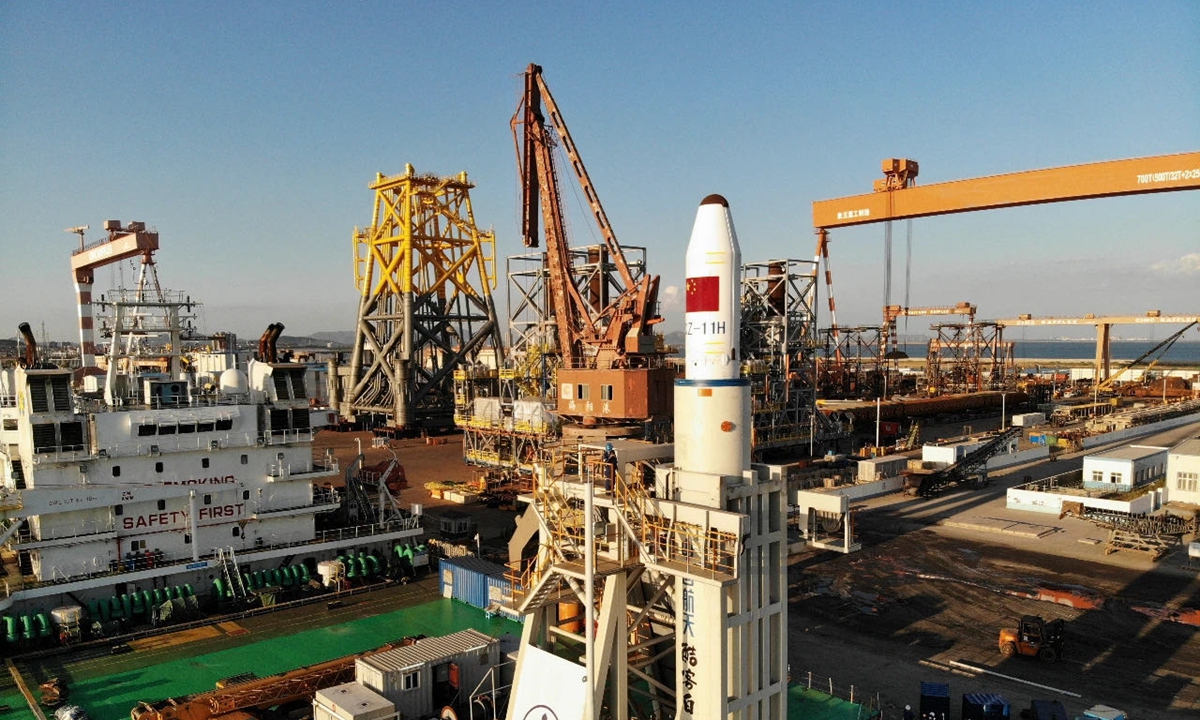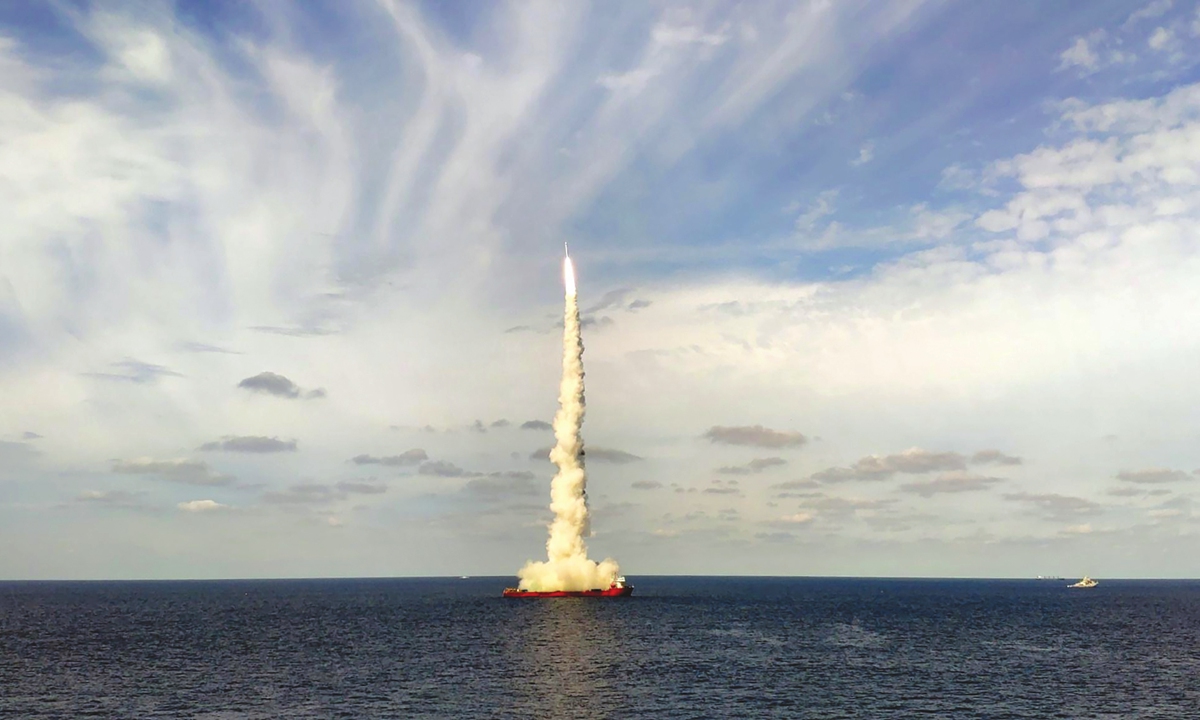Nation conducts second seaborne space launch
By Deng Xiaoci Source: Global Times Published: 2020/9/15 9:45:49
Video: Shi Xiao
China conducted its second seaborne space launch early Tuesday morning, with a Long March-11 solid propellant light launch vehicle lifting off from a mobile floating platform in the Yellow Sea, in waters off the coast of East China's Shandong Province.
Compared with the first launch, developers have further optimized and streamlined its sea launch capabilities by deploying a new launch vessel and putting a new coastal spaceport into operation, laying a solid foundation for more frequent and regular sea missions in the future.
The launch mission from sea successfully sent a group of nine commercial remote sensing satellites, all belonging to the Jilin-1 03 family, into the 535-kilometer Sun-synchronous orbit (SSO).
The group of satellites launched on Tuesday were developed by the Chang Guang Satellite Technology Co Limited based in Changchun, Northeast China's Jilin Province. The satellites will provide remote sensing data and a range of services including forestry, agriculture and maritime, for their clients.
"The Tuesday mission marked China's first commercial application launch from sea," Jin Xin, deputy commander-in-chief of the Long March-11 launch vehicle, told the Global Times on Tuesday.
The Long March-11 is a light-lift solid launch vehicle, around 20 meters in length with a diameter of 2 meters, weighing about 58 tons. Before the Tuesday launch, it had conducted nine successful flights, including China's first sea launch conducted in June 2019.
The assembly of the rocket for the Tuesday sea launch mission and the rocket-satellite installation were both carried out at the Dongfang Spaceport [also referred to as Eastern Aerospace Port]. The rocket was then transferred from Haiyang port in Haiyang of Shandong Province to its designated launch site. Peng Kunya, the chief designer of the Long March-11 with the China Academy of Launch Vehicle (CALT), which is overseen by the country's state-owned aerospace giant the China Aerospace Science and Technology Corporation (CASC), called it a "game-changer."
This practice streamlines the previous pattern, in which the manufacturing of the rocket and launch site were separate, by reducing disassembly and assembly times. It also cuts the time for long-distance rail transfer, greatly shortening the launch chain and significantly enhancing launch efficiency, Peng noted.

Photo: courtesy of the CALT
According to Peng, it was also the first Long March-11 sea launch mission to the SSO. "The angle for a launch to the SSO is fixed, and once the launch site is verified, it will become routine for future missions."
Also, sea launches can effectively mitigate against post-launch safety risks, as rocket debris will fall away from populated land areas, Peng said.
The developer team of the Long March-11 is working on a new solid propellant rocket model which has a two-ton payload launch capability to the Low Earth orbit, and it is expected to make its maiden experiment flight from sea by 2022, Li Tongyu, commander-in-chief of the Long March-11 carrier rocket, revealed to the Global Times.
Dubbed China's fifth space launch center, construction of the Dongfang Aerospace Port as a base for sea launches of light-lift solid rockets was approved in July 2019, and concrete progress has been made, according to the CALT.
With the new port now put into operation, China has now laid a foundation for regular future sea launches, CALT said in a statement to the Global Times.
The Tuesday launch site is located some 350 kilometers to the southeast of the Haiyang port in Shandong in the Yellow Sea. The rocket was transported by the Debo-3 ship to the designated site before being launched from the same ship.
The Debo-3 is 160 meters in length and 40 meters wide, and sails at a speed of some 20 kilometers per hour.
The Long March-11 maiden flight from the sea took place on June 5, 2019, and it lifted off from the large semi-submersible barge Tairui.
Unlike the Tairui, the Debo-3 can sail by itself, and is thinner and longer, making it more vulnerable to the weather and maritime conditions.
The ship development team conducted a mock experiment before the mission, and felt the new ship would be able to adapt well to the changing environment at sea.
The seaborne launch technology meets the growing demand for low inclination satellites and helps China provide launch services for countries participating in the Belt and Road Initiative, according to Chinese experts.

A Long March-11 solid-propellant light launch vehicle lifts off from a mobile floating platform in the Yellow Sea off the coast of East China's Shandong Province on Tuesday. Photo: VCG
Taiwan local media on Tuesday morning paid close attention to the launch mission, which took place in the Yellow Sea.
Some Taiwan media outlets called the Tuesday sea launch mission "a serious provocation" from the mainland, citing a mainland we-media Sina Weibo account that said in an earlier post that the rocket was expected to fly over the island of Taiwan after taking off.
The island's defense authorities said it had closely monitored and taken appropriate measures.
While Taiwan media obviously took the private account's post as an authoritative mainland voice and cooked up a new threat theory, Chinese space authorities had not disclosed the rocket's flight path as of press time.
Taiwan media also pointed out that the sea launch mission came after the island of Taiwan started the computer-aided war games phase of its Han Kuang drills, which see the Chinese People's Liberation Army as a "threat", on Monday.
"The launch mission is purely civilian and all satellites on board are for commercial use, which should not be overly connected with any political and military move," Song Zhongping, a mainland military and TV commentator, told the Global Times on Tuesday.
Also, the SSO orbit design has determined that the rocket would have to pass the island of Taiwan, which is very normal, Song noted. "It simply shows the guilty conscience of the Taiwan media and military as they deliberately hype the event," he added.
Posted in: SOCIETY,CHINA FOCUS